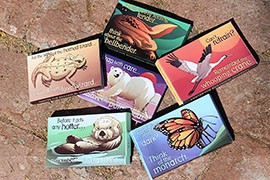- Slug: BC-CNS-Endangered Condoms,550
- Photos available (thumbnails, captions below)
By MIRANDA LEO
Cronkite News
WASHINGTON – The Tucson-based Center for Biological Diversity worries that Earth Day has moved away from its original focus on overpopulation, so it will bring that message back in an unusual package – 50,000 endangered species condoms.
The species-themed condom giveaway is just one of many ways supporters will mark the 45th annual Earth Day on Wednesday.
Officials at the Earth Day Network said the focus has expanded in the 45 years since the first Earth Day was celebrated as we have gained a better understanding of threats to the planet, and they said they welcome a range of activities. Even condoms.
The condoms, certified fair trade and made with sustainable rubber, have graphics of various endangered animals on their packages coupled with slogans like “before it gets any hotter, remember the sea otter.” They are, the center says, a creative way to start a dialogue about human overpopulation and the effects it has on endangering wildlife.
Stephanie Feldstein, the center’s population and sustainability director, said in a phone interview Monday that human overpopulation was an important part of Earth Day when it was created in 1970 that has since then slipped off the radar.
“There aren’t a lot of people talking about population anymore,” she said. “We really like to bring it back into the conversation.”
The center began using endangered species condoms as its Earth Day conversation starters in 2009, and said it has distributed a total of a half-million since. This year’s packages include polar bears, whooping cranes, monarch butterflies, sea otters, horned lizards and hellbender salamanders.
Attiya Sayyed, a communications and program associate at the Earth Day Network – founded by the organizers of the first Earth Day – said though the message of the day has changed over time, it hasn’t lost its original focus. It has just responded to science showing other environmental woes besides overpopulation.
Sandy Bahr, director of the Grand Canyon chapter of the Sierra Club, said that Earth Day’s evolution over the four-plus decades since its creation by late U.S. Sen. Gaylord Nelson, D-Wis., has been mostly positive.
“I think people have begun to do a broader range of things instead of just one big event,” Bahr said. “It’s a more dispersed and spread-out activity. There are more people from a broad range of backgrounds with more age diversity.”
Sayyed agreed, saying Earth Day has spread globally. She said the network coordinates with environmental organizations in Canada, India, Uganda and elsewhere across the globe on Earth Day activities, ranging from educating cities on how to be more green to planting a tree for every dollar in donations.
She laughed at the mention of the center’s condom giveaway, saying she thought they might have a box in the network’s Washington offices.
Bahr thinks the holiday has spread well, but worries the people today are less positive than they were at the first Earth Day and may be less confident that what they can do makes a difference.
“I think that there is a little more cynicism about taking action,” she said. “I think that that is a good challenge moving forward for Earth Day, to remind people that what they do matters.”
The Center for Biological Diversity will do its part, handing out its creative contraceptives at Earth Day events and venues across the country, including some in Phoenix, Prescott and Tucson.
^__=
Web links:
_ Condoms program: http://www.endangeredspeciescondoms.com/
_ Earth day network: http://www.earthday.org/
_ Arizona Sierra Club: http://www.sierraclub.org/arizona/
^__=
One of the endangered species condoms handed out for Earth Day by the Center for Biological Diversity to remind people of the dangers of overpopulation. (Photo courtesy the Center for Biological Diversity)
A sampling of this year’s endangered species Earth Day condoms from the Center for Biological Diversity. Art is by Shawn DiCriscio and package design by Lori Lieber. (Photo courtesy the Center for Biological Diversity)

